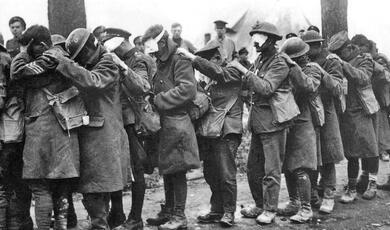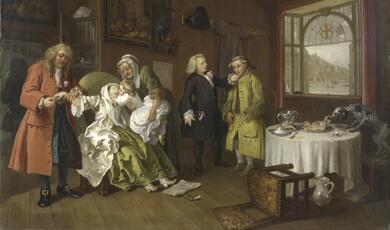Monogamy
Share
- Details
- Transcript
- Audio
- Downloads
- Extra Reading
Monogamy is a hotly contested practice. In many cis-gender marriages, engaging in sexual intercourse with a non-spouse is regarded as a serious betrayal. But during some periods in history, it was not only accepted but expected. 'Philanderers' are now portrayed as suffering from 'sex addiction'. What do these shifts reveal about gender and sexual relations? Has the proliferation of sexualities and genders, together with rapidly changing sexual mores, dealt a death blow to monogamy? Or is it stronger than ever?
Download Transcript
Monogamy
Professor Joanna Bourke
17th March 2022
Why is monogamy such a big deal? What can a history of fidelity and infidelity reveal about the changing rights, duties, and social meanings of marriage. Why have heterosexual, monogamous marriages been seen as the basis of western “civilisation”, despite the fact that couples who vow “I do” to monogamy actually “don’t”? Why does “criminal conversation” refer to sexual intercourse rather than talking about crime? What does polygamy have to do with same-sex marriage? And what is the point of exchanging “sex addict” for “promiscuous”. And how do I manage to speak about Hegel and Boris Johnson in the same lecture? These are just some of the questions I want to address today.
Let’s start with a nineteenth century woman who loudly decried monogamy, at a time when women simply did not speak of such things. In 1848, women’s rights reformer and health advocate Mary Gove married writer Thomas Low Nichols. She vowed:
In marriage with you, I resign no right of my soul. I enter into no compact to be faithful to you. I only promise to be faithful to the deepest love of my heart. If that love is yours, it will bear fruit for you, and enrich your life – our life. If my love leads me from you, I must go.
Mary Gove Nichols aligned monogamy with marital slavery. Alongside her husband, she travelled around the U.S. preaching a gospel of female wellbeing, dietary and dress reform, celibacy, and free love. She only married in order to be allowed to travel with her lover without being arrested under fornication or lewdness laws. The couple wrote books and articles together – including one simply entitled Marriage. It’s History, Character, and Results (1854), which attacked monogamy – and they published a periodical that attracted 20,000 subscribers. Mary Gove Nichols’s semi-autobiographical Mary Lyndon: Revelations of a Life (1855) scandalised society. Indeed, she was to become the most influential female opponent of monogamy and advocate of free love in mid-nineteenth century America. Throughout the 1840s and 1850s, she argued compellingly that wives had the right to say “no” to sex with their husbands and “yes” to sexual intercourse outside of marriage. She believed that women had a “right of self-ownership” and if this meant that “she chooses seven babes by seven men, what business is it of anyone else’s?” For her, love was a religion and therefore outside the authority of the state. This was heady stuff for the mid-nineteenth century. Even the most progressive feminists at the time considered her views too extreme: they shunned her company.
What is it about monogamy that generates such heated responses? Even today, 89 per cent of Americans believe it is “morally wrong” for a married person to have sex with someone who is not their spouse. To put this in perspective, the same survey found that only 28 per cent thought it was morally wrong for heterosexual unmarried people to have sex and 35 per cent disapproved of intercourse between members of the same sex. Americans abhor marital infidelity even more than they dislike abortion, pornography, cloning, and even polygamy.
Given such attitudes, it is no surprise to find that as many as 99 per cent of married, heterosexual Americans claim that they expect to have an exclusive sexual relationship with their spouse. But here is the irony: sexual exclusivity is unlikely. The stigma associated with infidelity seriously distorts the figures, but the best statistics show that one in every eight married women and nearly one in every four married men are “unfaithful” at some point in their marriage. Other estimates suggest that marital infidelity is closer to 60 per cent. The performative vow of “I do” at a wedding ceremony is no guarantee that the play will end with the same protagonists.
The insistence (against the odds) on monogamy within marriage is even more striking if we consider that just over one-sixth of cultures around the world are polygamous. These are mainly in the Middle East, Asia, and Africa. For example, between ten and twenty per cent of all households in Saudi Arabia and Yemen practice polygamy, as do around one-third of households in many African countries, such as Senegal and Tanzania.
In contrast, around 120 countries in the world either ban or do not recognise polygamy. For more than 2,500 years, legal systems in the West have been founded on the monogamous family. In these regions, the costs of adultery have been high. In eleventh century England, a female adulteress could be mutilated by having her nose or ears cut off; in the seventeenth century, there were times when it warranted the death penalty; and, prior to 1857, ecclesiastical courts could require the offender to do public penance draped in a white sheet. In England, prosecutions for adultery only ended in 1970. Today, 38 states in the U.S. have laws concerning adultery. It is a crime in almost 40 per cent of states and is grounds for divorce in almost two thirds. In some states, adulterous spouses forfeit inheritance rights, get a smaller share of the marital property, lose custody of children, and are refused the right to adopt. Courts have even upheld the rights of employers to fire employees who have “strayed” and have allowed landlords to discriminate against “fornicators”. The paramour of an adulterous partner may also be punished by being served with a tort suit for recovery of damages. These “heart balm actions” are hoped to “soothe” the offended spouse’s “broken heart”. The state continues to penalise private and consensual sexual relations between a married person and someone other than their spouse.
The seriousness with which monogamy is held can also be seen by the fact that a single act of infidelity could be grounds for dissolving the entire marriage. Not surprisingly, perhaps, there are strong gender disparities. In the West, divorce law rested on Emperor Constantine’s constitution, which stated that a husband could divorce his wife if she was “an adulteress, a poisoner or a conspirator”, while a wife could only divorce her husband if he was a “murderer, a prisoner, or a defiler of graves”. A husband’s adultery, therefore, was not considered a serious enough blow to a marriage to warrant its termination, unlike a wife’s adultery. A wife’s monogamy was essential to protect her husband’s “property”. The double standard of sexual morality was explained in terms of the need for confidence over the paternity of any offspring, whom the father would be required to support financially. But it was mainly due to the principle of coverture, which ruled that, once married, a woman’s “very being or legal existence” passed to her husband. A husband’s entitlements included the right to “conjugal affection”. The wife who was not monogamous, then, breached the property contract created by their marriage. A wife was allowed to cite her husband’s adultery as a ground for divorce, but she was still required to add an additional fault as well (such as cruelty). Even when “no fault” divorces started to be allowed from the 1970s, the costs to a wife of accusing her husband of non-monogamous behaviour or being accused herself was much higher for her husband. Accusing a husband could be financially disastrous; being accused, socially damaging.
Adultery legislation was not the only way that law enforced monogamy. A husband could seek damages from his wife’s paramour. “Criminal conversation”, as it was called (“conversation” meaning sexual intercourse), was used by husbands to punish their wife’s lover. It tells us a great deal about rights and gender disparities to note that “criminal conversation” was also used by husbands to recover damages from a wife’s rapist. Whether consensual or forced, the wife’s services, companionship, sexuality, and body were the property of the husband. In the words of the Supreme Court of New Hampshire in 1916, a husband was entitled to
the whole of his wife’s marital affection, and to the whole of such society and comfort as her physical state and mental attitude render her capable of affording him. He who steals any substantial part of that affection, or disables her physically or mentally from rendering such aid and comfort, is guilty of an infringement of the husband’s rights and should be required to make compensation.
Or, in the more pithy words of a 1904 case that went to the U.S. Supreme Court, a husband had a “property right” to his wife’s body – and this right was “of the highest kind, upon the thorough maintenance of which the whole social order rests”.
Legal understandings of the respective rights and duties of husbands and wives changed very slowly. Starting in the late nineteenth century, leading jurists and judges began allowing the argument that a wife also had an exclusive right to her husband’s sexual body. Legally, marriage was no longer a rigidly hierarchical arrangement in which the wife’s body was the property of her husband, but an institution founded upon reciprocal, emotional companionship. A wife was entitled to her husband’s “society and companionship”, so if the husband’s sexual relations with another person denied her these rights, she was entitled to undertake legal proceedings for adultery on the grounds that his affair had led to “abandonment, loss of support, or alienation of affections”. Importantly, this was not identical to suits for “criminal conversation” since, unlike husbands, a wife could not claim that the person of her husband was her property. This meant that she could not sue the husband’s paramour for damages based on the grounds that the affair caused a “loss of consortium” under the common law. In law, therefore, a husband’s breach of monogamy was a lesser form, since paternity was not at issue and the betrayed wife was not as socially disgraced by her husband’s actions. As one attorney explained, “the word cuckold is one of the most disgraceful epithets that can be applied to a husband – and the fact that there is no corresponding word… to apply to the wife” meant that the harm to the wife was less. A combination of the belief that, firstly, a wife did not “possess” her husband’s body and, secondly, male sexuality was less exclusive meant that her disgrace was proportionality smaller.
But there was another reason women could sue for “abandonment, loss of support, or alienation of affections” but not “criminal conversation”: the husband’s paramour was regarded as having less agency. She might also be a victim of male lusts. Requiring the female paramour to pay for damages was therefore unfair since it was often assumed that the “seducer” must have been the husband. It was a view of female sexuality as fundamentally passive. When, from the early twentieth century, the courts began to allow betrayed wives to take action for “criminal conversation”, they did this not on the grounds that a wife had property rights over her husband’s person but on the grounds that infidelity harmed the emotional contract of marriage. As historian Kimberley A. Reilly explains, “When courts recognized wives’ claims to the consortium of their mates, they did more than acknowledge the growing centrality of mutual affection to the marriage bond. Rather, they conceptualized marital companionship itself as the property of wives, no less than husbands”. It was the result of increased emphasis on “sexual compatibility and mutual exclusivity”. In Reilly’s words, “monogamy was more than an abstract moral standard; it was an obligation emerging from the marriage relation that formed the emotional core of the union. Therefore, it was legitimately within the law’s reach”. It tells us a great deal about the increased fusing of emotional and sexual components of marriage. By allowing wives to sue for “criminal conversation”, the courts were doing much more than simply acknowledging the emotional suffering of the wronged wife: they were also holding the paramour of the adulterous partner responsible for emotional harm. Monogamy had to be mutual.
So far in this talk, I have explored some of the ways that marital fidelity and infidelity have structured marriage, been central to divorce law, and created hierarchies of power and authority centring on the question of property rights over the sexed body of a spouse. These were some of the debates that Mary Gove Nichols was railing against when she argued that women had a “right of self-ownership” and the state should not intervene.
I now want to take the debates about monogamy to a more elevated level. After all, monogamy is concerned with much more than individual marriages, with their concessions, compromises, discontents, and disappointments. The monogamous marriage is both the subject and product of politics at the highest, abstract level. For philosophers as different as Francis Lieber and Georg W. F. Hegel, monogamy was the basis for the modern liberal state. For Lieber, who was writing in the mid nineteenth century, social institutions not only reflected ideas about morality, but constituted human moral character. He argued that the family was the most important social institution because it was the unit within which children were taught the central principles upon which the state rested. Within liberal societies, the heterosexual, monogamous family promoted reciprocal dependency, and, by emphasising the higher notions of love rather than base sexual desire, both initiated and maintained mutuality and altruism. These traits were necessary for the development and stability of the liberal state. In contrast, Lieber contended, polygamous societies promoted selfishness, sexual lust, and, by denying women the exclusive attention of their husbands, undermined their true vocation as homemakers and mothers. In short: monogamous households created liberal democratic states; polygamous ones led inevitably towards a politics that was tyrannical and patriarchal.
Hegel’s arguments were more intricate than Lieber’s. In Philosophy of Right (1821), Hegel argued that the liberal state and monogamous marriage were inseparable. Monogamy was “one of the principles on which the ethical life of a country depends more absolutely”. Individual personalities could only flourish within the confines of a heterosexual monogamous marriage, since that unit encouraged the surrender of personhood in the interests of other people with whom the individual forged free and rational ties, both emotionally and economically. This provided the basis from which future generations could develop into active citizens. For Hegel, this was in stark contrast to polygamy, which fostered selfishness in the “ruler” and enforced the subjugation of all the other members of the household. Discord and interpersonal competition were therefore inevitable. The patriarchal politics integral to polygamous marriages would result in a despotic, patriarchal state.
Clearly, these philosophical ideas about the relationship between marital monogamy and the state were highly gendered. For Hegel, women’s personhood was passive and emotional, while men’s was active and intellectual. As he put it in Philosophy of Right, “the difference between man and woman is the same as that between animal and plant. The animal corresponds more closely to the character of man, the plant to that of the woman”. This was why men were heads of households. He believed that “If women were to control the government, the state would be in danger for they do not act according to the dictates of universality, but are influenced by accidental inclinations and opinions”. In contrast, men attain “their position through stress of thought and much specialist efforts”.
The disruptive nature of lust was central to such arguments. In contrast to base sexual desire (which commentators assumed was at the heart of “promiscuity’ and polygamy), romantic love required individuals to transcend their singularity and recognise that their individuality was only possible through social unity. This made the romantic, monogamous heterosexual couple and their children receptive to the wider transcendence required by the liberal state. State licensing of monogamous marriage tied love between a couple to citizenship within a state. By allowing for the expression of unruly passions – albeit only within the regulatory confines of the monogamous family – sexual urges would be tempered. This was protective for both familial and national institutions. A psychoanalytic twist was given to this argument by Sigmund Freud when he insisted that the suppression or inhibition of the two innate drives – aggression and sex – were central to the maintenance of civilisation. Whether employing a philosophical or psychoanalytical frame of meaning, the monogamous family channelled sexual instincts to productive rather than destructive ends.
These debates become even more strident for commentators who were primarily curious about polygamy. Sociologist Edward Westermarck’s writings on marriage were enormously influential from the 1890s onwards. He admitted that there were many benefits to polygamy, at least for husbands. A husband did not have to be periodically continent, for example, when his wife was ill, pregnant, or menstruating. A polygamist man could enjoy the attractions of “female youth” since, Westermarck contended, “Even when a man… marries a woman of his own age, he may still be in the prime of life when the youthful beauty of his wife has passed for ever”. Polygamy also indulged “man’s taste for variety”, his desire for offspring and wealth, and his distain for housework. As Westermarck asked: “If I have but one wife, who will cook for me when she is ill?” However, these benefits of polygamy were far outweighed by the needs of “civilisation”, which always tended towards monogamous unions. In A Short History of Marriage (1926), Westermarck insisted that the
sentiment of love has become more refined and, in consequence, more enduring. To a cultivated mind youth and beauty are by no means the only attractions of a woman, and besides, civilisation has given female beauty a new lease of life. The feelings of the weaker sex are held in greater regard, and the causes which may make polygyny desired by the women themselves no longer exist.
The anonymous author of Rational Basis of Legal Institutions (1923) was less “even handed” when comparing polygamy and monogamy although, like Westermarck, he believed that civilisation required monogamous households. He contended that polygamy was “an institution of barbarism” and incompatible with “a high civilization”. This was primarily because it depended upon the “subjection and degradation of women” and would lead to the neglect of children or, at the very least, their inadequate socialisation. In contrast, children were given a “superior upbringing” in monogamous cultures. Monogamous families fostered “affections and emotions of the higher type”, including “altruism of the highest degree”. Crucially, this meant that monogamous marriage “created fatherhood in the fullest sense of the term”, teaching men the “value of service and self-sacrifice”. Strengthened family bonds, ultimately meant strong “social bonds” which, in turn, favoured “the development of higher types of religion and morals”. Such views were mainstream at the time. Polyandry (that is, one wife with many husbands) was said to foster paternal uncertainty and male rivalry. Polygyny (one husband and many wives) debases women, disrupts child raising, and leads to authoritarian private and public spheres. In contrast, monogamy signals respect for women, harmony in domestic and well as public spheres, and political stability.
These debates had consequences. They were integral to colonialist policies against Indigenous Americans, who were required to adopt monogamous family structures. As historian Nancy Cott explains, “Both political and religious officials assumed that indigenous Americans’ assimilation had to be founded on monogamous marriage, from which would follow the conventional sexual division of labor, property, and inheritance”. Similarly, after emancipation, formerly enslaved people acquired not only the right to marry but also the duty of monogamy. The Union Army’s “contraband” camps and the programmes run by the Freedman’s Bureau taught former slaves the need for fidelity within marriage and the husband’s obligation to support his family economically. Christian monogamy and citizenship were indivisible.
The imposition of monogamy resulted in laws disenfranchising bigamists and members of religious groups (such as Mormons) who supported polygamous marriages. This point was argued in Reynolds v. United States (1879), when the Supreme Court ruled that a federal law prohibiting polygamy did not violate the “free exercise of religion” clause of the First Amendment. It ruled that the criminalisation of Mormon polygamy was essential if the new state of Utah was to be a “free, self-governing commonwealth”. Good governance depended on the “idea of the family, as consisting in and springing from the union for life of one man and one woman in the holy estate of matrimony”. This was “the sure foundation of all that is stable and noble in our civilization; the best guaranty of that reverent morality which is the source of all beneficent progress in social and political improvement”.
Such discussions continue today. Concerns about the dangers posed by polygamy to personal as well political stability and liberal governance have been employed by homophobes opposing gay relationships and same-sex marriages. These opponents of homosexuality were emboldened by the AIDS crisis, because non-monogamy or “promiscuity” was identified as a key vector of HIV infection. They argued that same-sex couples were more “licentious” than their heterosexual counterparts: therefore, they deserved to be inflicted with the “Gay Plague”. Evangelist Pat Robertson expressed this view most viciously when he quipped: “AIDS is God’s way of weeding his garden”. But even liberal commentators made a distinction between monogamous, homosexual relationships (good) and “promiscuous” ones (bad). As historian Matt Cook argues, gay men who embraced the respectability associated with coupledom and monogamy were increasingly accepted; those who did not were stigmatised as vectors of disease.
There was another way that HIV/AIDS influenced debates about sexual relations. Gay liberation had tended to reject the claims of monogamy and coupledom. Instead, there was an emphasis on sexual pleasure and building a sense of a shared community. The AIDS crisis led to a questioning of these emphases as gay men adopted more monogamous pair-bonding. This only changed after infection routes became clearer. For their opponents, however, gay “promiscuity” was to become a central argument against same-sex marriage. They maintained that allowing same-sex couples to marry would send out a message that sexual relations within marriage need not be exclusive. Once again, the integrity of the heterosexual, monogamous marriage was seen to be essential to political stability, even of, in reality, it was flaunted by a significant proportion of heterosexual couples.
Finally, non-monogamous sex took on a new meaning with the invention of “sex addiction” from the 1970s onwards, and becoming particularly prominent in the 1980s and 1990s. While non-monogamous sex remained a “problem” due to the way it breached a moral code, such behaviour was increasingly refracted through a medicalised framework. It was no minor affliction: “sex addiction” has been said to afflict around the ten per cent of Americans.
Of course, this was not the first time that men and women who had obsessional urges to engage in sex with as many people as possible was medicalised. I explore these earlier forms in another lecture I gave at Gresham College (see the “Exploring the Body” lecture on “The History of the Clitoris and Penis”: https://www.gresham.ac.uk/lectures-and-events/history-penis-clitoris). In the earlier period, sexually voracious women were diagnosed with nymphomania, and attempts were made to calm their “engorged” or “irritated” clitorises. Treatment included everything from a vegetarian diet and cold baths to clitorectomies. The male equivalent of nymphomania was satyriasis, named after the half-man/half-beast Greek satyr. This infliction was widely believed to be a problem in Victorian society, which blamed it on modern men’s lack of will-power. Forensic physician Auguste Amboise Tardieu contended that the “erotic delirium” of satyriasis sufferers puts every woman at risk. Or, as William Acton explained, satyriasis was accompanied by a “maniacal sensuality that is one of the most awful visitations to which humanity can be subject”.
But sex addiction was a different beast altogether. It started as a grassroots, self-help movement in 1977 with the establishment of Sex and Love Addicts Anonymous (now, the Augustine Fellowship), and is now treated by mental health practitioners as an established mental disorder. The Sexual Dependency Unit at Golden Valley Health Centre (which established the first inpatient programme for sexual addicts in 1985 in Minneapolis) defined sex addicts as people who engage in “obsessive/compulsive sexual behaviour” that “causes severe stress to addicted individuals and their families”. Central to being diagnosed was the idea of (largely male) suffering. In the words of an Insight on the News article in 1998, President Bill Clinton’s sex addiction was the result of being abandoned by his mother and having an alcoholic stepfather. The author claimed that Clinton “turned to sex to disguise his pain…. The sex addict uses sex to deaden and avoid psychological pain and conflict”. The disorder was not a matter of sin or degeneration (as in its earlier incarnation as nymphomania and satyriasis), but a disruption of regulatory mechanisms in the brain. What used to be morally inexcusable behaviour was turned into an illness to be treated. Since it was a physiological infliction, independent of the sufferer’s will-power, it was also psychologically excusable.
How did the fairly unexceptional practice of having sex with multiple people who are not your partner come to be described in the literature as a “devastating disease” and a “form of insanity”? The invention (or “discovery”) of Hypersexual Behaviour Disorder was part of a response to a conservative trend from the 1970s that identified the source of a large range of societal problems (from crime to AIDS) as a decline in sexual self-control: “promiscuity”, pornography, sex work, and gay liberation became central targets. As we have seen in previous lectures, radical feminists also engaged in these debates, deploring male sex addicts for their casual victimisation of women and accusing female sex addicts of false consciousness and self-harming behaviours. At the heart of these arguments are the virtues of monogamy. Sexaholics Anonymous informs its members that
Any form of sex with one’s self or with partners other than the spouse is progressively addictive and destructive. Thus, for the married sexaholic, sexual sobriety means having sex only with the spouse, including no form of sex with one’s self. For the unmarried…. freedom from sex of any kind. For all… progressive victory over lust.
In other words, even sexual fantasies and masturbation are dangerous and, for married men, a form of infidelity. Sin is in the mind as well as the flesh. It is a repressive and, ultimately, self-defeating conservative rhetoric that inhibits the full flourishing of people’s lives. A sharp distinction is made between “good sex” – that is, heterosexual, monogamous intercourse with a spouse – and “bad sex” – promiscuous, fantasy-driven, and queer.
In conclusion: what does this brief history of monogamy tell us about our recent history? It sheds light on what married people expect from their partners. The double standard of sexual morality of the nineteenth century, for example, in which the monogamy of wives was exponentially more important than that of husbands. It traces the increasing importance of emotional exclusivity within marriage. In recent decades, this has spread to virtual realms. For example, an ABC poll in 2004 found that over forty per cent of women and one-quarter of men believe that visiting a pornographic website is incompatible with a monogamous relationship. In 2009, one-third of divorces were blamed on virtual infidelity. This emphasis on emotional intimacy between couples changes the very meaning of “monogamy”, drawing attention away from straying sex organs towards fickle hearts. Its history reminds us of the huge societal investment in monogamy. It has been central to ideas about property – both human property (is the wife’s body hers or is it subsumed under her husbands?) and material goods (how are assets distributed after divorce?). The history of monogamy also draws attention to conflicts between laws and ideals on the one hand, and actual practices on the other. Presidents and politicians can be heard loudly condemning the polygamous practices of certain immigrant groups, while a blind-eye is turned to the serially adulterous practices of, for example, world-leaders Francois Mitterrand, Franklin D. Roosevelt, Bill Clinton, and Boris Johnson, as well as a sizable minority of its own citizens.
The future of monogamy is less certain. The significantly higher rates of non-monogamous behaviour amongst men used to be explained in terms of “parental investment theory” whereby women’s greater responsible for care of the offspring had meant that have a higher investment in monogamy. But, for women, the costs of infidelity have been rapidly declining in recent decades, due to birth control, access to abortion, and improved employment options. Recent decades have also seen the rise of polyamory and other sex-positive household structures. Unlike more traditional forms of polygamy, polyamory tends towards radical postmodernist approaches to sex. Such relationships often include members of the same-sex or gender-fluid individuals. The legalisation of same-sex marriage has emboldened them to press for the legalisation of group marriages, as well as to emphasise polyfidelity as similar to “good” monogamous marriages.
But whatever turns out to be the future of monogamy (and historians are not soothsayers), its history suggests that what we do with our sexed bodies – whom we touch, when and why we do so, and what it all means – will continue to excite the imagination of people like Mary Gove Nichols, for whom love is a religion, the only true “good”. As she promised in her marriage vows: “If that love is yours, it will bear fruit for you, and enrich your life – our life. If my love leads me from you, I must go.”
© Professor Bourke 2022
Previous lecture series on ‘The Body’, ‘Evil Women’, and ‘Sex’ can be found at https://www.gresham.ac.uk/professors-and-speakers/professor-joanna-bourke/
Follow me on twitter: @bourke_joanna; shme_bbk
and take a look at my SHaME (Sexual Harms and Medical Encounters) project: shame.bbk.ac.uk
References and Further Reading
Joanna Bourke, What It Means to be Human (London: Virago, 2011)
Patricia Cline Cohen, “The ‘Anti-Marriage Theory’ of Thomas and Mary Gove Nichols”, Journal of the Early Republic, 34.1 (Spring 2014)
Matt Cook, “AIDS, Mass Observation, and the Fate of the Permissive Turn”, Journal of the History of Sexuality, 26.2 (May 2016)
Nancy F. Cott, Public Vows: A History of Marriage and the Nation (Cambridge, Mass.: Harvard University Press, 2000)
Janice M. Irvine, Disorders of Desire: Sexuality and Gender in Modern America (Philadelphia: Temple University Press, 2005)
Kimberley A. Reilly, “Wronged in Her Dearest Rights: Plaintiff Wives and the Transformation of Marital Consortium”, Law and History Review, 31.1 (2013)
References and Further Reading
Joanna Bourke, What It Means to be Human (London: Virago, 2011)
Patricia Cline Cohen, “The ‘Anti-Marriage Theory’ of Thomas and Mary Gove Nichols”, Journal of the Early Republic, 34.1 (Spring 2014)
Matt Cook, “AIDS, Mass Observation, and the Fate of the Permissive Turn”, Journal of the History of Sexuality, 26.2 (May 2016)
Nancy F. Cott, Public Vows: A History of Marriage and the Nation (Cambridge, Mass.: Harvard University Press, 2000)
Janice M. Irvine, Disorders of Desire: Sexuality and Gender in Modern America (Philadelphia: Temple University Press, 2005)
Kimberley A. Reilly, “Wronged in Her Dearest Rights: Plaintiff Wives and the Transformation of Marital Consortium”, Law and History Review, 31.1 (2013)
Part of:
This event was on Thu, 17 Mar 2022
Support Gresham
Gresham College has offered an outstanding education to the public free of charge for over 400 years. Today, Gresham plays an important role in fostering a love of learning and a greater understanding of ourselves and the world around us. Your donation will help to widen our reach and to broaden our audience, allowing more people to benefit from a high-quality education from some of the brightest minds.


 Login
Login







